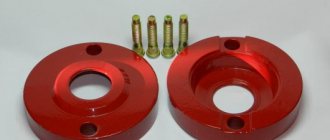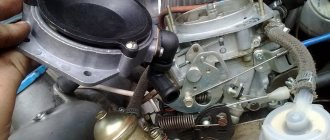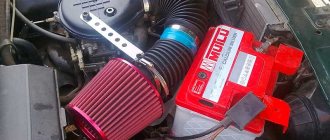Dump truck GAZ-SAZ 53B
The dump truck has a shortened frame by 300 mm, which is why the spare wheel was moved under the body behind the driver. Both suspensions are on leaf springs, shock absorbers are installed only on the front suspension. On the first releases of trucks, the edges of the main sheets were bent and formed an “ear” for fastening, and at this point they were fastened through the bushing using spring pins.
The gasoline tank is located under the driver, the filler neck is located immediately behind the driver's door. The modification was carried out from 1966 to 1984; in addition to Saransk, cars with dumping equipment were produced at the Frunzensky Automobile Assembly Plant.
The most famous truck from the times of the USSR is considered to be the GAZ-53, in addition, it also surpassed its counterparts in terms of production quantity. GAZ-53 can be classified as a medium-tonnage truck.
The GAZ-53 truck has rear-wheel drive, and various modifications of trucks were produced on its basis, including dump trucks. GAZ 53 dump trucks were marked as GAZ-SAZ 53B. GAZ 53 dump trucks were produced from 1966 to 1974.
Cabin
The dump truck cabin has space for two people. Such a dump truck could load 3.5 tons, despite the fact that the weight of the equipped dump truck reached 3 tons 750 kg. The dump truck was 6.38 m long, 2.475 m wide, and 2.575 m high. Its wheelbase reached 3.7 m.
Engine
Like all 53 models, the GAZ 53 dump truck was equipped with a carburetor engine that could run on both natural gas and gasoline. The engine was installed V-shaped with eight cylinders. The engine consumed 24 liters per 100 km, which is not so much for trucks of that time.
V-shaped engine for GAZ 53 dump truck
Transmission
The gearbox is mechanical, consisting of four stages. The GAZ 53 dump truck was equipped with a single-plate dry clutch and a single hypoid final drive. The steering was equipped with a pair of globoid worms with a three-ridge roller. The tire diameter was 20 inches.
Although the production of a dump truck based on the GAZ 53 was discontinued a long time ago, this modification of the truck is still on the road, and therefore a sufficient number of people are interested in its technical characteristics and tips for repairing this truck.
Chassis characteristics
The dump truck was equipped with a 4.25 liter 8-cylinder engine, its cylinder block and cylinder heads were cast from Al 4 aluminum alloy. The gearbox was 4-speed manual, the vehicle had rear-wheel drive.
Dump truck gearbox
- Length/width/height of the cabin – 6.4 m/ 2.47 m/ 2.2 m;
- Load capacity – 3.5 tons;
- Curb weight - 3.75 tons;
- The weight of a fully loaded vehicle is 7.4 tons;
- Ground clearance (clearance) – 0.265 m;
- Wheelbase – 3.7 m;
- Fuel consumption per 100 km at a speed of 40 km/h – 24 l;
- Tire size – 8.25-20 inches;
- The rated power of the internal combustion engine is 115 hp. With.;
- Engine type – carburetor;
- The compression ratio in the engine cylinders is 7.6;
- Steering – worm-type steering mechanism, without power steering;
- The number of seats in the cabin is two, including the driver.
Tipper equipment
The GAZ-SAZ 53B dump truck is released from the load by tipping the body. The direction of unloading can be side or rear. The body of the Gas 53 dump truck is metal, the vehicle's load capacity is less than that of the flatbed version.
Tipping the dump truck body sideways
The dump truck body drive is hydraulic. The lifting device is a hydraulic cylinder; the hydraulic system uses liquid oil; the hydraulic cylinder is rigidly connected to the platform. The cylinder is filled with oil through pipelines by a gear pump, which in turn is driven by the power take-off. Depending on which part of the cylinder is filled with oil, the body is raised or lowered. The lifting and lowering is controlled by a crane; it contains three valves:
- Body lowering valve;
- Safety valve;
- Check valve.
The lowering valve allows oil to flow into the oil tank when the pump is not running and the platform is lowered.
Drawing of the mechanism of the GAZ 53 dump truck
The safety valve limits the maximum pressure in the system to 115–120 kgf/cm², preventing overload at a load capacity higher than the established norm. The check valve prevents spontaneous lowering of the body.
The hydraulic cylinder of the device is telescopic, it contains three plungers. At the bottom of the cylinder (at the bottom) there is a fitting for filling the cavity with oil. The device itself contains three plungers - one per telescopic section of the hydraulic cylinder. The installed protective rings on the plungers protect the rubbing surfaces from dirt and dust.
The oil tank of the dump truck is located behind the cab, between the metal body and the frame. The tank is metal, welded, made of stamped thin steel sheets. There is a plug at the bottom to drain the oil, and an oil filter at the top. The oil filter has a fitting at the inlet that connects to the control valve.
Diesel car engine
The engine on the GAZ-53 (ZMZ-53) truck is a V-shaped, eight-cylinder (two rows of four cylinders), carburetor type, operating on a four-stroke cycle.
The working volume of the internal combustion engine cylinders of the GAZ-53 car is 4.25 liters (with a cylinder cross-sectional size of 92 mm and piston strokes of 80 mm).
Technical specifications for power 115 hp. With. The GAZ-53 engine is started using a starter.
The nominal crankshaft revolutions per minute are 3,200. The mixture compression ratio is 6.7.
Systems and mechanisms
The cylinder block is made of casting from Al-4 alloy, after casting it is sealed by heat treatment and impregnation with synthetic resin. This is a monoblock V-shaped design with an angle along the cylinder axes of 90 degrees.
The cavities of the block and cast iron liners for the pistons form the water cooling jacket of the engine. The possibility of repair replacement of sleeves is provided (5 groups with letter designations). The clutch housing is secured to the end of the block with threaded rods.
The piston group is cast from Al-30 aluminum alloy. The piston is round in shape with a flat bottom; three grooves are cut into its body for oil scraper and compression rings.
Pistons are divided into 5 repair groups according to their own diameter (letter marking) and into 4 groups according to the diameter of the piston pin hole (color marking).
The block heads are made of Al-4 alloy. Valve seats are made of cast iron, guide bushings are made of copper-graphite ceramics. The block and cylinder heads are connected by threaded rods through gaskets made of asbestos board reinforced with steel.
The crankshaft is cast from cast iron, with connecting rod journals, bearings and counterweights formed on it. The shaft undergoes dynamic and static balancing.
Axial movement of the crankshaft is eliminated by two washers installed on either side of the first journal support. It is sealed in the block with oil-sinking grooves, oil seals and asbestos packing.
The gas distribution mechanism with overhead valve installation ensures the intake of the working mixture into the cylinders and the exhaust of exhaust gas.
The device consists of: camshafts and gears, pushers, rocker arms, rods, valves, guide bushings and springs.
The camshaft is forged from steel. It has five bearing journals, cams, a gear drive for an oil pump and an ignition distributor.
The power system includes: a 90-liter gas tank, pipelines, a mechanically driven diaphragm pump, fuel filtering devices and a two-chamber K-126 carburetor - a device for preparing a fuel-air mixture.
The lubrication system supplies oil to the rubbing parts under pressure and gravity. Gear oil pump driven by a camshaft, full-flow oil filter, serviceable.
The air preparation filter is serviceable, inertial, with sedimentation of polluting particles in an oil bath.
Cooling system with water pump, closed type, liquid. It consists of a water jacket of the cylinder block, radiator, pump, thermostat, shutters, fan, fan casing, radiator cap and connecting hoses. Capacity – 22 liters. Contact ignition system.
Saransk dump truck plant
The Saransk plant has been operating since 1960, since August. By the end of the first year of its existence, the company had assembled about 10 thousand dump trucks. The plant constantly exceeded the plan and was in good standing, and by 1965 it had already produced its 100,000th dump truck. In the first years, the GAZ-SAZ 53B model rolled off the assembly line; in parallel, the SAZ 3502 model was produced with one-sided unloading of the body and its preliminary lifting. By November 1978, the company had already assembled half a million cars.
Auto device
The design of this unit is simple and reliable, thanks to which the GAZ-53 is widely used as an inexpensive truck that is unpretentious in maintenance. Studying its design, we can identify several key components that deserve separate consideration:
- power unit;
- additional systems and mechanisms necessary for the operation of the car;
- electrical equipment.
You should also note the cardan shaft, an important element of which is a cross in the amount of 3 pieces.
Engine GAZ-53
The power unit of this model is considered one of the most durable, since it relatively rarely requires serious repair work. Its identification number is ZMZ-53, it has a displacement of 4.25 liters and a power of 115 hp. The engine runs on gasoline, is of the V-type, equipped with 8 cylinders.
They are made of a special grade of aluminum, not only the cylinder body, but also their head parts. The diameter of each is 9.2 cm, the operating principle is 4-stroke. Its power is quite enough for driving on the highway exceeding the maximum speed declared by the manufacturer, but only if there is no load.
Despite the fact that, according to the documentation supplied with the car, its fuel consumption is 24 liters per 100 km, such a figure may not correspond to real figures. Consumption increases significantly when the car is loaded, as well as driving on uneven roads, in rain or snow.
Car GAZ-SAZ-3507
Since the beginning of 1984, the Saransk plant has mastered the production of the new GAZ-SAZ-3507 truck. Subsequently, its modifications were developed:
- GAZ-SAZ-35071 with a diesel engine D-245 (based on the GAZ 3309);
- GAZ-SAZ-3507-01 with a ZMZ-5231 gasoline engine (based on the GAZ 3307);
- GAZ-SAZ-25041 with tilting only backwards and preliminary lifting of the body.
Characteristics of the GAZ 33072 chassis
For the GAZ-SAZ-3507-01 model, the basis was the chassis of the GAZ 33072 dump truck. The technical characteristics of the chassis are as follows:
- Engine – ZMZ 5231 (gasoline), eight cylinders, V-shaped;
- Engine power – 125 hp. With.;
- Number of seats in the cabin – 2 (including the driver);
- Load capacity – 4.25 tons;
- Constant maximum speed – 90 km/h;
- Wheel drive – rear (4x2);
- Wheelbase - 3.77 m;
- Fuel consumption per 100 km at a speed of 60 km/h – 19.6 l;
- The weight of a fully loaded vehicle is 7.94 tons;
- Curb weight - 3.6 tons;
- Vehicle dimensions (length/width/height) – 6.47/ 2.4/ 2.46 m, height with extended sides – 2.88 m;
- The fuel used is A-80 gasoline.
source
What is the capacity of the GAZ-53 dump truck body, how many cubes, how many buckets of coal are there?
The GAZ -53 dump truck served reliably in our Soviet and post-Soviet times, regardless of the weather in any season of the year. Good technique. I had the opportunity to work a little on the GAZ-SAZ 53 B model. Its declared carrying capacity was 3.5 tons. The cubic capacity of the body was 5 cubic meters. We also had to transport coal. If we loaded it in the rain, we took less in volume, since wet coal is heavier than dry coal, and much more so. Therefore, we loaded it differently, and for some, the capacity of the body increased by increasing the sides and they “took” 4 tons. “Lawn” mastered this without any strain. I can’t tell you how many buckets of coal—they’ve never counted them, but they can be counted. Let's say we take a 12-liter bucket. It holds at least 12 kg. coal (again, depending on what kind: dry or wet). Thus, if we ideally take the load according to the declared carrying capacity, then in buckets it will be: 3500 kg. : 12 kg/bucket = almost 292 buckets.
The question reminded me of the question about the gazelle, and the same with the Lawn, the volume in the body is quite large, but this does not mean that the entire body along the sides can be loaded with coal.
Coal is quite heavy, and the carrying capacity of the GAZ-53 is limited to approximately 4 tons, so from this we get that if the most popular brand of coal among the population, “seed”, weighs from 1.5 to 1.8 tons per cubic meter, then we get this calculation.
The lawn can be loaded with approximately 2.2 to 2.6 cubic meters maximum, of which approximately 220-260 buckets of coal.
this volume is far from being a full body, as it is written in the question about how much it will fit, since if the lawn is fully loaded with about 6 cubic meters, then it will not be able to transport about 10 tons of coal.
Body dimensions of GAZ 53 - 3740*2170*680 mm. Multiplying these indicators, we get a volume of 5.2 cubic meters. This is the volume of the factory body along the edges of the sides. Load capacity - 4 tons. Of course, the cubic capacity of the body can be easily increased by making stripes. Craftsmen increase the cubic capacity by 1.5, 2, or even 2.2 times. Usually, stripes of the same height are made on factory sides. Then the body volume will be about 11 cubic meters.
Technical characteristics of the GAZ-53 dump truck and other modifications
For use in agriculture and forestry, industry and transport, the Gorky Automobile Plant produced more than 4 million GAZ-53 units. Based on the chassis of models 53F, 53A and 53-12, trucks for various purposes were produced: fire engines, vacuum trucks, milk tankers, sewage tanks, vans and buses. GAZ-5319 and 5327 operated on liquefied and compressed gas. The GAZ-53 dump truck was produced in 1966-74, was labeled GAZ-SAZ-53B and was intended for transporting bulk materials on various roads.
Modifications of GAZ-53
The plant produced several modifications of the truck, which differed in the design of the front part of the cab, the power of the power unit, the design of transmission elements and lighting equipment. The standard 90-liter fuel tank was located by default in a niche under the cab, with the filler located on the side behind the driver's door.
Some vehicles used an additional tank with a capacity of 105 liters, located on the frame side member.
GAZ-53F
The first samples of the truck, designated GAZ-53F, were shipped at the end of 1961. Under the hood was a 6-cylinder lower valve engine with a power of 82 hp. With. (boosted version of the unit from GAZ-51A). The car was distinguished by the design of the front end; the headlights were located above the side lights. The truck retained the rear axle of a split design, the front springs were installed in rubber supports, which reduced the labor intensity of maintenance. The car was removed from the assembly line in early 1967; as of January 2021, no surviving copies have been found.
GAZ-53F has a 6-cylinder engine.
GAZ-53A
Modification with an 8-cylinder engine with a capacity of 115 hp. With. and with a carrying capacity of 4000 kg began to be produced in the summer of 1965. The truck was distinguished by the design of the front end, there was a rear axle of the “banjo” type with a hypoid main pair. The plant produced a chassis for installing special superstructures (for example, platforms for transporting garbage); the box had a window for mounting a hydraulic system pump.
There was a special chassis 53-02 for the construction of a dump truck (under the GAZ-SAZ-53B brands).
GAZ-53-12
Model 53-12 was distinguished by an increased load capacity of up to 4500 kg and a 120-horsepower engine with screw intake channels. The rear suspension had reinforced springs, and there were no synchronizers in the box. The modernization made it possible to reduce fuel consumption by 7%; the truck remained on the assembly line until 1992.
GAZ-53-12 has an increased carrying capacity.
GAZ-5327
This model was produced for only 8 years and the last car came off the assembly line in 1992. The engine, which produced 100 hp, was designed to be fueled with propane.
Other modifications
The plant offered more than 100 modifications of the GAZ-53, designed for various operating conditions. For example, in the 80s. last century, an onboard 53-19 was produced with an engine designed to use gasoline and liquefied petroleum gas. For the needs of the KaVZ, SaRZ and TaRZ enterprises, a bus chassis with shock absorbers for the rear axle and an improved braking system was assembled. The GAZ plant offered equipment in a tropical version or designed for operation in the Far North.
Technical characteristics and design of vehicle components
Thanks to its high technical characteristics and maintainability, the dump truck continues to operate not only in industrial enterprises, but also in private households. The all-metal, durable body has extension sides and is released from the load by tipping on 3 sides.
A hydraulic cylinder is used as a lift. The power take-off drives a gear pump, which fills the system with oil through pipelines.
The GAZ-53 dump truck has a 2-seater all-metal cabin. Inside the cabin there are places to store tools and spare parts. The instrument panel does not contain an ammeter or oil pressure sensor. Instead, there are signal lamps. The passport number is located on the lower flange of the right side of the cab. The gasoline tank is located under the driver's seat, and the filler tank is located behind the cab, near the door.
Engine
The dump truck was equipped with different types of engines. At the initial stage, a GAZ-11 engine with 6 cylinders and a power of 82 hp was used. With. with 4-level transmission. The vehicle reached speeds of up to 75 km/h and had a load capacity of 3.5 tons. Fuel consumption per 100 km reached 22-25 liters. After modernization, a ZMZ-53 unit with 115 liters was installed. With. Consumption of A-76 gasoline remained unchanged.
To increase the power performance, the 53-12 chassis was equipped with a 4-stroke V-shaped carburetor gasoline unit from the Zavolzhsky Motor Plant ZMZ-511.10.
- Number of cylinders - 8.
- Working volume - 4.25 l.
- The cylinder diameter is 92 mm.
- Piston stroke - 80 mm.
- The operating order is 1-5-4-2-6-3-7-8.
- Rated power - 88.5 liters. With.
- Engine oil pressure is 250 kPa.
- The fuel consumption rate of the GAZ-53 is 19.6 l/100 km.
Differences between the 53A line and the 53
The car models have the following differences:
- reinforced front axle;
- new cardan design;
- more reliable steering gear design;
- new radiator grille;
- turn signals are duplicated by repeaters on the wings of the cabin;
- the presence of electric windshield wipers;
- cabin heating.
In 1973, model 53A was awarded the USSR State Quality Mark. Expanding the functionality of the vehicle, the production of chassis 53 01 for covered bodies and special equipment was launched.
Chassis 53 02 was a platform for the use of a dump truck body and was equipped with a power removal device for a hydraulic pump.
Trucks of models 53 50 and 53 70 were exported. The vehicles were readily purchased in Belgium, Finland, and in socialist countries. In Bulgaria and Cuba, trucks were assembled from kits supplied from GAZ.
Model 53 12 was produced from 1983 to 1992, as a further development of the 53rd line. The truck was equipped with an eight-cylinder ZMZ-511 engine.
Power parameter is 120 hp. With. made it possible to increase the load to 4.5 tons, and the speed indicator to 90 km/h.
Gasoline consumption increased to 30 liters, but provision was made for installing equipment for refueling with liquefied or compressed gas.
Technical characteristics of the basic on-board vehicle GAZ-53:
| Index | Unit change | Meaning |
| Production period | 1964-1983 | |
| Limit dimensions (length, width, height) | mm | 6 395, 2 380, 2 220 |
| Fuel consumption | l/100 km | 24 |
| Total places | 3 | |
| Load | kg | 4 000 |
| Fully loaded weight | kg | 7 400 |
| Base between wheel axles | mm | 3 700 |
| Ground clearance is minimal | mm | 265 |
| Speed | km/h | up to 85 |
| Power unit | ZMZ-53 | |
| Clutch mechanism | one disk, dry type, with lever drive | |
| checkpoint | by four steps | |
| Rear axle main gear | single, conical, hypoid | |
| Steering column | globoid worm and three-comb roller | |
| Tire size | 8,25-20 | |
| Brake device | drum-type mechanism on all axes, with hydraulic drive |
Maintenance and repair
Due to long-term use, wear and depreciation of parts, the truck may fail and require restoration measures. Repair work is carried out at a service station or independently if you have knowledge of the mechanics and kinematics of trucks, as well as in accordance with the operating manual.
Engine malfunctions and repairs
Routine repair of the GAZ-53 engine is carried out for the following malfunctions:
- knocking in the engine;
- reduced compression in the cylinders;
- malfunction of one of the cylinders (motor trouble);
- water pump noise;
- coolant leak from the control hole;
- rapid overheating of the unit;
- increased oil consumption;
- low or high oil pressure.
Overhaul of the engine is carried out at the end of its service life or wear of parts. The overhaul includes:
- boring the crankshaft to fit the dimensions of the liners;
- replacement of worn-out spare parts;
- grinding and grinding of valves;
- inspection of the cam camshaft, connecting rod and piston group, gear connection of the oil pump, clutch disc.
The service life of the motor depends on the quality of the parts being repaired and the correct running-in of the rubbing surfaces.
Pump repair
Repair of the GAZ-53 pump is performed if the following symptoms are present:
- coolant leaking through the water pump impeller seal;
- large shaft play in bearings;
- boiling of liquid when the engine is running for a short time.
Malfunctions are eliminated by replacing the sealing washer, oil seal seals and roller bearing.
Adjustment of valves
Adjustment of the GAZ-53 valves is carried out when fuel consumption increases, engine speed decreases and characteristic noise is detected in the carburetor and exhaust pipe. As the load increases, the clearance on the camshaft valve becomes larger. To adjust the valves, you need to pull the piston of the first cylinder to top dead center (TDC) using a gear pointer. The recommended gap is 0.25-0.3 mm. The process is carried out using an adjusting screw and a 0.25 mm probe.
Carburetor adjustment
Adjusting the carburetor on your own consists of measuring and checking the gaps between the throttle and air dampers and their bodies, low crankshaft speed when the engine is idling, and adjusting the opening angle of the throttle valve with the air damper completely closed.
How to set the ignition
Unstable operation of the ignition system leads to such malfunctions as:
- The coil is heating up.
- Breakdown in high voltage cables.
- Burnt cover on the transfer case.
- Shot of candles.
If popping sounds appear in the intake manifold, it is necessary to set the ignition to GAS according to the marks. Instructions for installing the ignition on a GAZ-53 look like this:
- The piston in cylinder 1 is installed at TDC and the marks are aligned.
- The crankshaft is turned counterclockwise until the “9” mark on the indicator aligns with the line on the pulley.
- Unscrew the bolt of the upper element of the manifold.
- Connect the first control cable to the body, the second to the breaker.
- Turn on the ignition.
- The breaker is turned until the contacts open.
- Tighten the mounting bolt, install the cover and rotor.
- On the opposite side, the spark plug on cylinder 1 is connected to a high voltage cable, the remaining wires are connected according to the diagram 1-5-4-2-6-3-7-8.
Dependence of fuel consumption on various factors
A truck cannot constantly move only on a straight, flat asphalt road, and at the same time drive empty. The following factors influence the increase in fuel consumption:
- Machine load level;
- Warming up a cold engine (especially in winter);
- Driving style. Driving with constant sharp acceleration dramatically increases gasoline consumption. Also, do not drive in low gear at high speed or too fast;
- Malfunctions in the carburetor or in the engine itself. Even non-working spark plugs can affect consumption;
- Chassis or brake malfunctions, low tire pressure;
- Road conditions. Going uphill also requires more fuel consumption;
- Poor quality gasoline, clogged air filter.
Device
The frame on which the body is attached has 6 or 7 transverse beams (here an additional one was welded on, due to necessity). A front axle made of steel is fixed in front of the frame on two springs. At the ends of the front axle there are steering knuckles, where the wheels are attached using axles. The front wheels are single, with telescopic shock absorbers. The rigid frame of the truck is reinforced at the rear with a drive axle beam. There are springs on both sides. They are semi-elliptical and connected to the frame.
Between the frame and the springs there is a so-called rubber cushion. In addition, the rear suspension has additional springs. The rear wheels of this vehicle are double (two wheels on each side), for better maneuverability and stability. A well-thought-out shock absorption system allows the car to drive at a decent speed over all sorts of bumps on a dirt road without any consequences for the car.
Be sure to read: Toyota Hino-300: photos, load capacity and other characteristics
A tug is attached to the back of the car, at the end of the frame. The spare wheel is mounted on the left. It was for its forethought in all cases that people in rural areas fell in love with this car. Cranes were even made on the basis of this machine: the body was removed, the rigid frame was strengthened with cross members, and the Gas 53 crane was bolted onto the chassis frame. In villages you can see these rarities of technology. They are still working.
Gas 53 - dump truck
Chassis
The transmission, control and running gears are connected in series. Cheap, economical parts were used. At the same time, these parts are of good quality, made of high-quality metal. The clutch is designed for changing gears, braking, and for different driving modes. The connection of the clutch assembly elements is made in such a way that when the pedal is pressed, a rod is activated, which is connected by a lever to the release fork. The four-speed gearbox transmits movement through meshing gears in second and third gears. The third and fourth gears are engaged using a synchronizer. Engaging second gear is assisted by a gear clutch. The gearbox allows you to change the speed, makes it possible to move in reverse, and allow the engine to idle. Then the engine runs and the car stops.
Gear shifting is done in two steps. The cardan transmission has two shafts with hinges at the end. Torque is transmitted to the main gear. It transmits movement through the differential to the axle shafts of the driving rear wheels. The differential is also designed to level out the ride on uneven roads and when cornering. This prevents the wheels from slipping, which means the tires wear out less. In the rear axle there is a crankcase into which oil is poured with a volume of up to 8.2 liters. Oil makes the gears work easier. The crankcase is made of cast ductile iron. To cool the engine, there is a radiator in front of the car behind the bumper. Water, 21 liters, is poured into it to cool the engine while it is running. After work, if the car is left outside in winter, the water is drained so that the water in the radiator does not freeze.
Be sure to read: Lomovoz with a manipulator: device, characteristics




